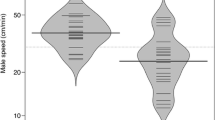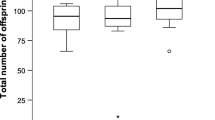Summary
The addition of frequency dependence to the marginal value theorem (MVT) model of the dung fly (Scatophaga stercoraria) male's optimal copula duration makes virtually no difference to the predicted competitive optimum (ESS). However, this evolutionarily stable strategy (ESS) version allows an explicit solution for the optimum. In a general sense, MVT optima will be close to their ESS equivalent when the cycle duration (expected time between the starts of two successive patch exploitations) is long relative to the plausible patch exploitation times. The optimal copula duration for male dung flies will depend on the ratio of virgin to mated females arriving at the droppings and on whether a male can discriminate between the two sorts of female. In nature, we found only an average of 3% of the total females arriving at the droppings to be virgins, rather less than had been estimated. This means that matings away from droppings (“extra-dung matings”) must be much commoner than previously suspected. Cumulative gains through copulation time rise much more steeply with virgins than with mated females, and so if males are able to discriminate, on the present model, we calculate that the ESS copula durations (at 20° C) would be around 42 min for non-virgins and 11 min for virgins. If they do not discriminate, the ESS is to copulate for a fixed duration of 41.5 min, i.e. very close to the optimum for mated females. The data indicate that copula duration does not differ for the two types of mating (mated females; virgins), suggesting that males cannot discriminate (or that the copula duration with virgins is not optimised to male interests). ESS copula durations with discrimination are almost entirely independent of the frequency of virgins in the population of females arriving at the droppings; without discrimination the optimal copula duration shifts between the ESS for mated females and that for virgins as the virgin frequency increases from 0 to 1. But at their naturally occurring frequency of only 3%, virgins can be ignored from calculations of optimal copula duration without significant loss of precision.
Similar content being viewed by others
References
Charnov EL (1976) Optimal foraging: the marginal value theorem. Theor Popul Biol 9:129–136
Gibbons DS (1987) The casue of seasonal changes in numbers of the yellow dung fly, Scathophaga stercoraria (Diptera: Scathophagidae). Ecol Entomol 12:173–185
Hammer O (1941) Biological and ecological investigations on flies associated with pasturing cattle and their excrement. Vidensk Meddr Dansk Naturh Foren 105:1–127
Krebs JR (1978) Optimal foraging: decision rules for predators. In: Krebs JR, Davies NB (eds) Behavioural ecology: an evolutionary approach. Blackwell, Oxford, pp 23–63
Krebs JR, McCleery RH (1984) Optimization in behavioural ecology. In: Krebs JR, Davies NB (eds) Behavioural ecology: an evolutionary approach, 2nd edn. Blackwell, Oxford, pp 91–121
Krebs JR, Kacelnik A (1991) Decision-making. In: Krebs JR, Davies NB (eds) Behavioural ecology: an evolutionary approach, 3rd edn. Blackwell, Oxford, pp 105–137
Maynard Smith J (1982) Evolution and the theory of games. Cambridge University Press, Cambridge
Parker GA (1970a) Sperm competition and its evolutionary effect on copula duration in the fly Scatophaga stercoraria J Insect Physiol 16:1301–1328
Parker GA (1970b) The reproductive behaviour and the nature of sexual selection in Scatophaga stercoraria L. (Diptera: Scatophagidae). II. The fertilization rate and the spatial and temporal relationships of each sex around the site of mating and oviposition. J Anim Ecol 39:204–228
Parker GA (1970c) The reproductive behaviour and the nature of sexual selection in Scatophaga stercoraria L. (Diptera: Scatophagidae). V. The female's behaviour at the oviposition site. Behaviour 37:140–168
Parker GA (1971) The reproductive behaviour and the nature of sexual selection in Scatophaga stercoraria L. (Diptera: Scatophagidae). VI. The adaptive significance of emigration from the oviposition site during the phase of genital contact. J Anim Ecol 40:215–233
Parker GA (1978) Searching for mates. In: Krebs JR, Davies NB (eds) Behavioural ecology: an evolutionary approach. Blackwell, Oxford, pp 214–244
Parker GA (1984) Sperm competition and the evolution of animal mating strategies. In: Smith RL (ed) Sperm competition and the evoluation of animal mating systems. Academic Press, New York, pp 1–60
Parker GA (1992) Marginal value theorem with exploitation time costs: diet, sperm reserves, and optimal copula duration in dung flies. Am Nat 139:1237–1256
Parker GA, Simmons LW (1991) A model of constant random sperm displacement during mating: evidence from Scatophaga. Proc R Soc Lond B 246:107–115
Parker GA, Simmons LW, Kirk H (1990) Analysing sperm competition data: simple models for predicting mechanisms. Behav Ecol Sociobiol 27:55–65
Parker GA, Stuart RA (1976) Animal behavior as a strategy optimizer: evolution of resource assessment strategies and optimal emigration thresholds. Am Nat 110:1055–1076
Simmons LW, Parker GA (1992) Individual variation in sperm competition success in dung flies, Scatophaga stercoraria. Evolution 46:366–375
Ward PI (1985) The marginal value theorem: an analytical theorem for the optimum. Z Tierpsychol 69:340–343
Ward PI, Simmons LW (1990) Short-term changes in numbers of the yellow dung fly Scathophaga stercoraria (Diptera: Scathophagidae). Ecol Entomol 15:115–118
Ward PI, Simmons LW (1991) Copula duration and testes size in the yellow dung fly, Scathophaga stercoraria (L.): the effects of diet, body size, and mating history. Behav Ecol Sociobiol 29:77–85
Yamamura N, Tsuji N (1987) Optimal patch time under exploitation competition. Am Nat 129:553–567
Author information
Authors and Affiliations
Additional information
Correspondence to: G.A. Parker
Rights and permissions
About this article
Cite this article
Parker, G., Simmons, L. & Ward, P. Optimal copula duration in dungflies: effects of frequency dependence and female mating status. Behav Ecol Sociobiol 32, 157–166 (1993). https://doi.org/10.1007/BF00173773
Received:
Accepted:
Issue Date:
DOI: https://doi.org/10.1007/BF00173773




